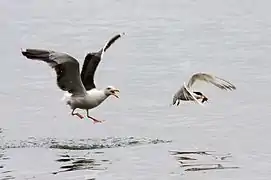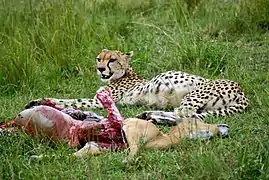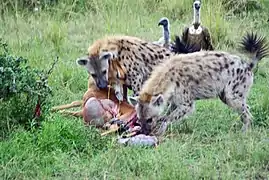
Kleptoparasitism (originally spelt clepto-parasitism,[1][2] meaning "parasitism by theft") is a form of feeding in which one animal deliberately takes food from another. The strategy is evolutionarily stable when stealing is less costly than direct feeding, such as when food is scarce or when victims are abundant. Many kleptoparasites are arthropods, especially bees and wasps, but including some true flies, dung beetles, bugs, and spiders. Cuckoo bees are specialized kleptoparasites which lay their eggs either on the pollen masses made by other bees, or on the insect hosts of parasitoid wasps. They are an instance of Emery's rule, which states that insect social parasites tend to be closely related to their hosts. The behavior occurs, too, in vertebrates including birds such as skuas, which persistently chase other seabirds until they disgorge their food, and carnivorous mammals such as spotted hyenas and lions. Other species opportunistically indulge in kleptoparasitism.
Strategy
Kleptoparasitism is a feeding strategy where one animal deliberately steals food from another. This may be intraspecific, involving stealing from members of the same species, or interspecific, from members of other species.[3][4] The term denotes a form of parasitism involving theft, from Greek κλέπτω (kléptō, 'steal').[5] The strategy has been widely studied in birds; in four families, all seabirds, the Fregatidae, Chionididae, Stercoraridae, and Laridae, it occurs in more than a quarter of the species.[6][4]
Such a strategy should only be followed if it is evolutionarily stable, meaning that it offers a selective advantage to individuals that practise it. Kleptoparasitism costs time and energy which could otherwise be spent directly on feeding, so this cost must be outweighed by the benefit in energy gained from the stolen food. Mathematical modelling suggests that when food is abundant, ordinary feeding is the best strategy; when food abundance falls below a critical level, kleptoparasitism suddenly becomes advantageous, and aggressive interactions become common. Similarly, when potential victims are rare or widely dispersed, the time needed to find them may not be justified by the food that might be stolen from them, resulting in frequency-dependent selection.[3][6]
Taxonomic distribution
Arthropods
Bees and wasps

There are many lineages of cuckoo bees, all of which lay their eggs in the nest cells of other bees, often within the same family.[7] Bombus bohemicus, for example, parasitises several other species in its genus, including B. terrestris, B. lucorum, and B. cryptarum.[8] These are instances of Emery's rule, named for the Italian entomologist Carlo Emery, which asserts that social parasites among insects, including kleptoparasites, tend to be closely related to their hosts.[9][10] The largest monophyletic lineage of kleptoparasitic bees is Nomadinae (a subfamily of Apidae), which comprises several hundred species in 35 genera.[11]
| Host genus | Parasite genus |
|---|---|
| Bombus | Bombus (Psithyrus) |
| Anthophora | Melecta, Zacosmia |
| Amegilla | Thyreus |
| Megachile | Coelioxys |
The cuckoo wasps (Chrysididae) lay their eggs in the nests of potter and mud dauber wasps. Other families of wasps have "cuckoo" species that parasitise related species, as for example Polistes sulcifer, which parasitises a related species, P. dominula.[12][13] Numerous other wasp families have genera or larger lineages of which some or all members are kleptoparasitic (e.g., the genus Ceropales in Pompilidae and the tribe Nyssonini in Crabronidae).[7] Some of these species are inquilines and brood parasites rather than kleptoparasites.[14]
Others are dubbed kleptoparasitoids, namely parasitoids that select hosts that have been parasitized by another female. Kleptoparasitoids may make use of the punctures made by previous parasitoids on their hosts; may follow the trails or traces left by parasitoids to locate hosts; or use hosts already weakened by other parasitoids.[15]
Flies

Some true flies (Diptera) are kleptoparasites; the strategy is especially common in the subfamily Miltogramminae of the family Sarcophagidae. There are also some kleptoparasites in the families Chloropidae and Milichiidae. Some adult milichiids, for example, visit spider webs where they scavenge on half-eaten stink bugs. Others are associated with robber flies (Asilidae), or Crematogaster ants.[16] Flies in the genus Bengalia (Calliphoridae) steal food and pupae transported by ants and are often found beside their foraging trails.[17] Musca albina (Muscidae) reportedly shows kleptoparasitic behaviour, laying eggs only in dung balls being interred by one of several co-occurring dung-rolling scarab species.[18]
Dung beetles
Scarab dung beetles relocate large amounts of vertebrate dung, rolling balls of the material to their nests for their larvae to feed on. Several smaller species of dung beetle do not gather dung themselves but take it from the nests of larger species. For example, species of Onthophagus enter dung-balls while Scarabeus beetles are making them.[19]
True bugs

Many semiaquatic bugs (Heteroptera) are kleptoparasitic on their own species. In one study, whenever the bug Velia caprai (water cricket) took prey heavier than 7.9 g, other bugs of the same species joined it and successfully ate parts of the prey.[20]
Spiders

Kleptoparasitic spiders, which steal or feed on prey captured by other spiders, are known to occur in five families:
- Theridiidae (Argyrodes species)
- Dictynidae (Archaeodictyna ulova)
- Salticidae (species of Portia and Simaetha)
- Symphytognathidae (Curimagua bayano)
- Mysmenidae (Isela okuncana, Kilifia inquilina, and Mysmenopsis species).[21]
Vertebrates
Birds
A few bird species are specialist kleptoparasites, while many others are opportunistic. Skuas (including jaegers) and frigatebirds rely heavily on chasing other seabirds to obtain food. Other species—including raptors, gulls, terns, coots, and some ducks and shorebirds—do so opportunistically. Among opportunists such as the roseate tern, parent birds involved in kleptoparasitism are more successful in raising broods than non-kleptoparasitic individuals.[22][23] Bald eagles have been seen attacking smaller raptors, such as ospreys, to steal fish from them.[24] Among passerine birds, masked shrikes have been recorded stealing food from wheatears,[25] and Eurasian blackbirds have been recorded stealing smashed snails from other thrushes.[22]
During seabird nesting seasons, frigatebirds soar above seabird colonies, waiting for parent birds to return to their nests with food for their young. As the returning birds approach the colony, the frigatebirds, which are fast and agile, swoop in to pursue them vigorously; they sometimes seize tropicbirds by their long tail plumes. The name frigatebird, as well as many of the frigatebirds' colloquial names, including man-o'-war bird and pirate of the sea, denote this behaviour.[26] However, the amount of food obtained by kleptoparasitism in the magnificent frigatebird may be marginal.[27]
Gulls are both perpetrators and victims of opportunistic kleptoparasitism, particularly during the breeding season. While the victim is most often another member of the same species, other (principally smaller) gulls and terns can also be targeted. In the Americas, as brown pelicans surface and empty the water from their bills, they sometimes have their food stolen by Heermann's gulls and laughing gulls, which lurk nearby and grab escaping food items.[28] Great black-backed gulls are skilled kleptoparasites, stealing from other gulls and from raptors. Several species of gull steal food from humans, for example takeaway food at seaside resorts.[29]
 Western gull in pursuit of an elegant tern
Western gull in pursuit of an elegant tern The flying cormorant has taken a fish from the one in the water.
The flying cormorant has taken a fish from the one in the water.
Mammals
The relationship between spotted hyenas and lions, in which each species steals the other's kills,[30] is a form of kleptoparasitism.[20] Cheetahs are common targets. Bears, coyotes and wolves are very opportunistic and all have this behavior. All hyena species engage in this behavior when they can, as do jackals.[31] Human hunters may commonly take the remains of fresh kills from other carnivores, such as lions and Eurasian lynx.[32][33][34] Risso's dolphins have been observed charging "head-on" at sperm whales, causing them to open their mouths; it has been suggested that the observed harassment results in some regurgitation, and that the food is then eaten by the Risso's dolphins. The behaviour is rare and may be opportunistic.[35]

 A little later, hyenas have driven off the cheetah and are feeding.
A little later, hyenas have driven off the cheetah and are feeding.
See also
References
- ↑ Rothschild, M.; Clay, T. (1957). Fleas, Flukes and Cuckoos. A study of bird parasites. New York: Macmillan. p. 10.
- ↑ Proffitt, M., ed. (1997). "kleptoparasitism". Oxford English Dictionary. Additions Series. Vol. 3. New York: Oxford University Press. p. 145. ISBN 978-0-19-860027-5.
- 1 2 Broom, Mark; Ruxton, Graeme D. (1998). "Evolutionarily stable stealing: game theory applied to kleptoparasitism". Annals of Human Genetics. 62 (5): 453–464. doi:10.1111/j.1469-1809.1998.ahg625_0453_5.x. S2CID 56407575.
- 1 2 Furness, R. W. (1987). "Kleptoparasitism in seabirds". In Croxall, J. P. (ed.). Seabirds: feeding ecology and role in marine ecosystems. Cambridge: Cambridge University Press. ISBN 978-0521301787.
- ↑ Nishimura, K. (2010). "Kleptoparasitism and Cannibalism". Encyclopedia of Animal Behavior. Elsevier. pp. 253–258. doi:10.1016/b978-0-08-045337-8.00279-5. ISBN 9780080453378.
- 1 2 Brockmann, H. Jane; Barnard, C. J. (1979). "Kleptoparasitism in birds". Animal Behaviour. 27: 487–514. doi:10.1016/0003-3472(79)90185-4. S2CID 53151684.
- 1 2 3 Slater, Peter J. B.; Rosenblatt, Jay S.; Snowdon, Charles T.; et al. (30 January 2005). Advances in the Study of Behavior. Academic Press. p. 365. ISBN 978-0-08-049015-1.
- ↑ Kreuter, Kirsten; Bunk, Elfi Bunk (2011). "How the social parasitic bumblebee Bombus bohemicus sneaks into power of reproduction". Behavioral Ecology and Sociobiology. 66 (3): 475–486. doi:10.1007/s00265-011-1294-z. S2CID 7124725.
- ↑ Deslippe, Richard (2010). "Social Parasitism in Ants". Nature Education Knowledge. Retrieved 25 May 2022.
- ↑ Emery, Carlo (1909). "Über den Ursprung der dulotischen, parasitischen und myrmekophilen Ameisen" [On the Origin of Dulotic, Parasitic, and Myrmecophilic Ants]. Biologisches Centralblatt (in German). 29: 352–362.
- ↑ Roig-Alsina, A. (1991). "Cladistic analysis of the Nomadinae s. str. with description of a new genus (Hymenoptera: Anthophoridae)". Journal of the Kansas Entomological Society. 64 (1): 23–37. JSTOR 25085241.
- ↑ Dapporto, L.; Cervo, R.; Sledge, M.F.; Turillazzi, S. (2004). "Rank integration in dominance hierarchies of host colonies by the paper wasp social parasite Polistes sulcifer (Hymenoptera, Vespidae)". Journal of Insect Physiology. Elsevier BV. 50 (2–3): 217–223. doi:10.1016/j.jinsphys.2003.11.012. PMID 15019524.
- ↑ Ortolani, I.; Cervo, R. (2009). "Coevolution of daily activity timing in a host-parasite system". Biological Journal of the Linnean Society. 96 (2): 399–405. doi:10.1111/j.1095-8312.2008.01139.x.
- ↑ Erler, S.; Lattorff, H. M. G. (2010). "The degree of parasitism of the bumblebee (Bombus terrestris) by cuckoo bumblebees (Bombus (Psithyrus) vestalis)". Insectes Sociaux. 57 (4): 371–377. doi:10.1007/s00040-010-0093-2. S2CID 853556.
- ↑ Kraaijeveld, A. R. (1999). "Kleptoparasitism as an explanation for paradoxical oviposition decisions of the parasitoid Asobara tabida". Journal of Evolutionary Biology. 12: 129–133. doi:10.1046/j.1420-9101.1999.00016.x.
- ↑ Wild, A.L. & Brake, I. 2009. Field observations on Milichia patrizii ant-mugging flies (Diptera: Milichiidae: Milichiinae) in KwaZulu-Natal, South Africa. African Invertebrates 50 (1): 205–212. Archived 2009-05-15 at the Wayback Machine
- ↑ Sivinski, J., S. Marshall and E. Petersson (1999) Kleptoparasitism and phoresy in the diptera. Florida Entomologist 82 (2) Archived 2008-09-10 at the Wayback Machine
- ↑ Marshall, S.A. & Pont, A.C. (2013). The kleptoparasitic habits of Musca albina Wiedemann, 1830 (Diptera: Muscidae). African Invertebrates 54(2): 427–430.
- ↑ Hammond, P. M. (September 1976). "Kleptoparasitic Behaviour of Onthophagus suturalis Peringuey (Coleoptera: Scarabaeidae) and Other Dung-Beetles". The Coleopterists Bulletin. 30 (3): 245–249. JSTOR 3999694.
- 1 2 Erlandsson, Ann (1988). "Food sharing vs monopolising prey: a form of kleptoparasitism in Velia caprai (Heteroptera)". Oikos. 53 (2): 203–206. doi:10.2307/3566063. JSTOR 3566063.
- ↑ Coyl, F. A.; O'Shields, T. C.; Perlmutter, D. G. (1991). "Observations on the behaviour of the kleptoparasitic spider, Mysmenopsis furtiva (Araneae, Mysmenidae)" (PDF). Journal of Arachnology. 19: 62–66. Archived from the original (PDF) on 2006-05-13. Retrieved 2006-07-11.
- 1 2 Ehrlich, Paul R.; Dobkin, David S.; Wheye, Darryl; Pimm, Stuart L. (1994). The Birdwatcher's Handbook. Oxford: Oxford University Press. ISBN 0-19-858407-5.
- ↑ Shealer, David A.; Spendelow, Jeffrey A.; Hatfield, Jeff S.; Nisbet, Ian C. T. (2005). "The adaptive significance of stealing in a marine bird and its relationship to parental quality". Behavioral Ecology. 16 (2): 371–376. doi:10.1093/beheco/ari008. hdl:10.1093/beheco/ari008.
- ↑ Jorde, D.G.; Lingle, G (1998). "Kleptoparasitism by Bald Eagles wintering in South-Central Nebraska" (PDF). Journal of Field Ornithology. 59 (2): 183–188. Archived from the original (PDF) on 2007-08-10. Retrieved 2007-08-21.
- ↑ Harris, Tony; Franklin, Kim (2000). Shrikes & Bush-Shrikes. London: Christopher Helm. ISBN 0-7136-3861-3.
- ↑ Sibley, David (2001). The Sibley Guide to Bird Life and Behaviour. London: Christopher Helm. ISBN 0-7136-6250-6.
- ↑ Calixto-Albarrán, Itzia; Osorno, José-Luis (2000). "The diet of the Magnificent Frigatebird during chick rearing". The Condor. 102 (3): 569–576. doi:10.1650/0010-5422(2000)102[0569:tdotmf]2.0.co;2. S2CID 84078011.
- ↑ del Hoyo, Josep; Elliott, Andrew; Sargatal, Jordi, eds. (1996). Handbook of Birds of the World. Vol. 3. Barcelona: Lynx Edicions. ISBN 84-87334-20-2.
- ↑ Sample, Ian (7 August 2019). "Stare seagulls out to save your snacks, researcher says". The Guardian. Retrieved 1 September 2022.
- ↑ Estes, Richard D. (1999). The Safari Companion: A Guide to Watching African Mammals. Chelsea Green. p. 294. ISBN 1-890132-44-6.
- ↑ Estes, op. cit., 281–295, 339–346
- ↑ Walker, Matt (24 July 2009). "People steal meat from wild lions". BBC Earth News. Retrieved 2009-08-01.
- ↑ Schoe, Marjolein; de Iongh, Hans H.; Croes, Barbara M. (6 Jul 2009). "Humans displacing lions and stealing their food in Bénoué National Park, North Cameroon". African Journal of Ecology. Blackwell. 47 (3): 445. doi:10.1111/j.1365-2028.2008.00975.x.
- ↑ Krofel, Miha; Kos, Ivan; Linnell, John; Odden, John; Teurlings, Ivonne (2008). "Human Kleptoparasitism on Eurasian Lynx (Lynx Lynx L.) in Slovenia and Norway" (PDF). Varstvo Narave. 21: 93–103. Archived from the original (PDF) on 2022-06-16. Retrieved 2022-05-25.
- ↑ Smultea, Mari A.; Bacon, Cathy E.; Lomac-MacNair, Kate; Visser, Fleur; Bredvik, Jessica (2014). "Rare Mixed-Species Associations Between Sperm Whales and Risso's and Northern Right Whale Dolphins Off the Southern California Bight: Kleptoparasitism and Social Parasitism?". Northwestern Naturalist. 95 (1): 43–49. doi:10.1898/nwn13-11.1. ISSN 1051-1733. S2CID 86227330.